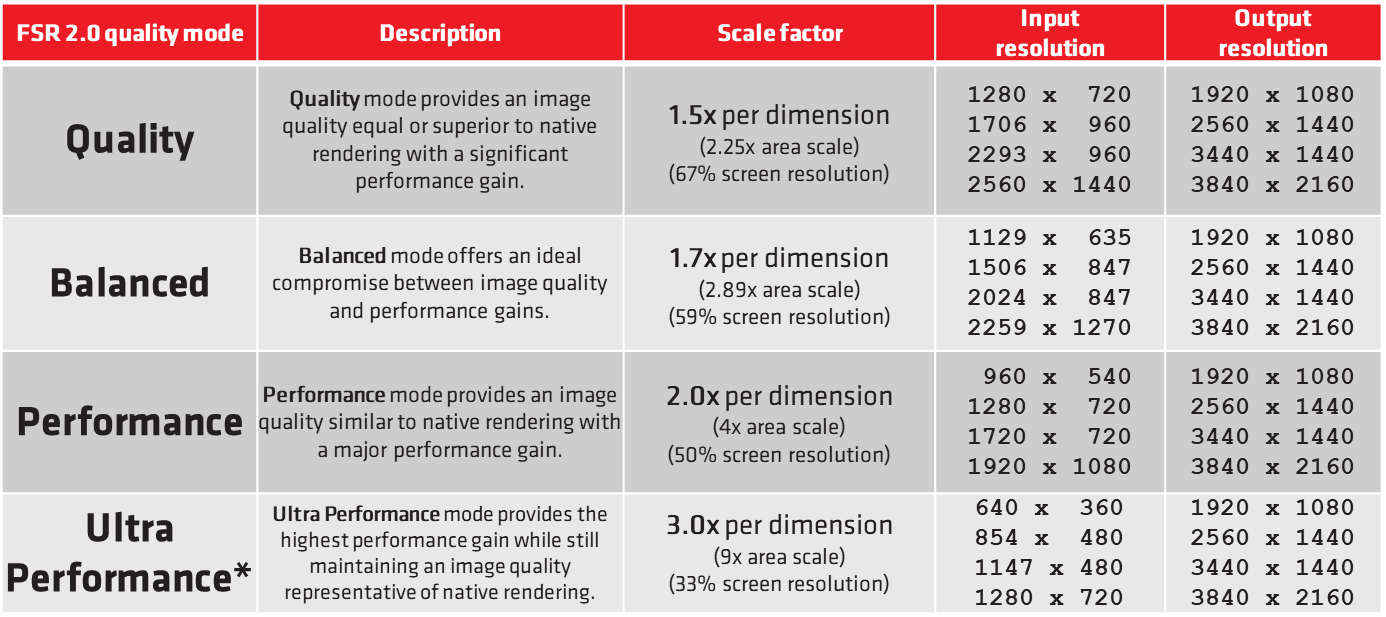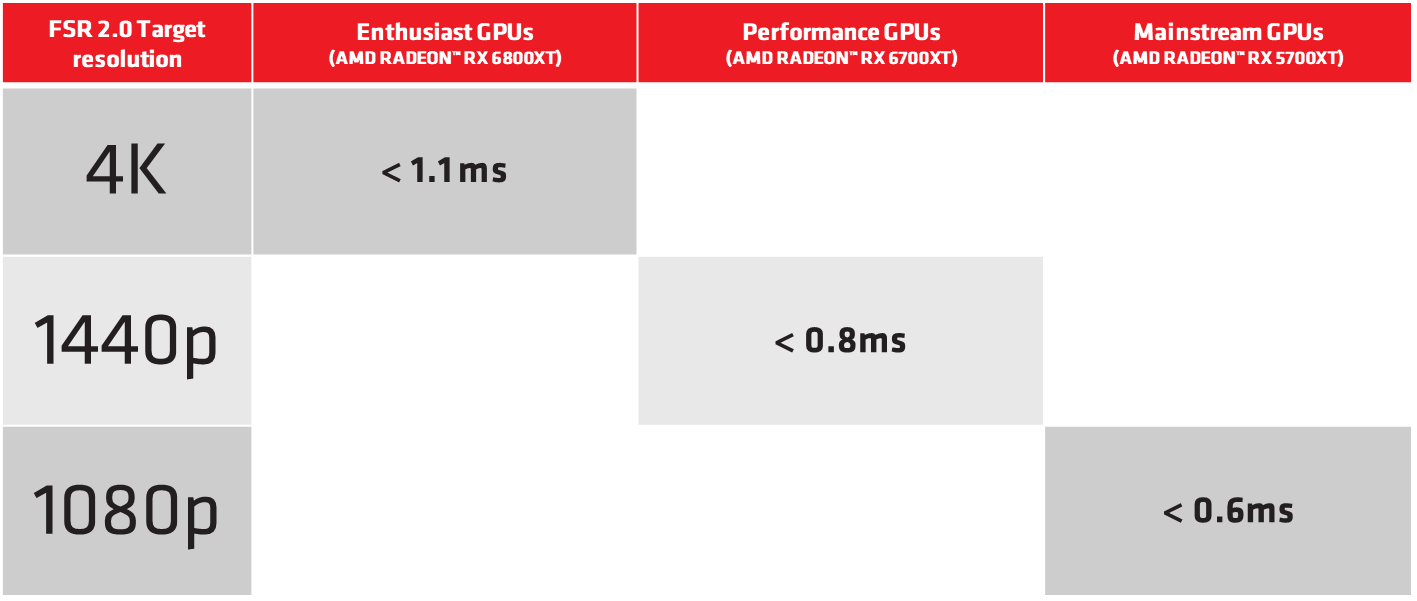I am CPU limited in MSFS, not GPU limited. If FSR doesn’t provide as good quality as native resolution, or if it doesn’t help fix the nasty shimmering issue, I probably won’t be using it.
Early leaks say that FSR 2.0 can look better than native rendering, and we already know that sometimes DLSS does too in some cases (Martial claimed it fixes the building shimmering issues and that they use it as a reference for temporal upsampling technologies). So unless it looks better, it won’t be of use to CPU-limited users indeed, but most of the playerbase is GPU-limited anyway.
And now it is confirmed via leaked official slides.
https://cdn.videocardz.com/1/2022/03/AMD-FSR-2.0-Features.png
https://cdn.videocardz.com/1/2022/03/AMD-FSR2-Demo.jpg
Sounds a lot like DLSS 2.x (temporal upsampling with a built-in anti-aliasing solution), except that machine learning is not required so it works on all hardware. Very exciting!
FSR 2.0 is now officially announced by AMD.
Coming in Q2 2022 with Deathloop being the first game to support it. Temporal upsampling with much higher quality than FSR 1.0 (comparison screenshots and videos can be found in the blog post), no machine learning required, wide support for both AMD and competitors’ GPUs, and very importantly, open-source like FSR 1.0.
Both open-source so I definitely want to see what Asobo has to say about this. It looks really good.
Updated the thread title as FSR 2 is miles better. Hopefully it will be available soon enough and Asobo will consider it.
That’s great, thanks for updating the title! Since Asobo finally changed their minds about DLSS recently, hopefully FSR 2.0 won’t be too much of a stretch.
Adding to my previous posts, here are some image comparisons by Twitter users, created using AMD’s official Deathloop shots.
Native 4K vs. FSR 1.0 Performance vs. FSR 2.0 Performance

As we can see, just like DLSS 2.x, the FSR 2.0 temporal reconstruction algorithm is better at resolving thin lines and fine texture detail over native rendering and typical TAA (and TAAU of course). As such, we can assume that it will also be capable of fixing the building shimmering issue (which Asobo claimed DLSS does in the latest Q&A stream).
Martial said the shimmering issue wasn’t really an issue on “PC” which was incorrect. Maybe he meant “2D” instead of “PC”, but that would still be incorrect. I play in 2D and still get a lot of shimmering depending on the area and time of day/weather I am flying.
I really have my doubts that DLSS or FSR 2.0 would fully resolve it, but we’ll see.
Just tried using RSR on FS2020, boosted my FPS by 20+!!!
What are your settings?
Reducing from 1080p to 900p does not apply any upscaling here, it just looks like default 900p, even if the Adrenalin software shows the green check mark in RSR.
Welp, watched the Q&A of today, no mention of FSR… Think they forgot it ![]()
As a heads-up, the GPUOpen page has been updated with a lot more information.
For games that already support DLSS 2.x (which MSFS will with Sim Update 10), it takes less than 3 days by the developers to implement FSR 2.0 (click on the image to see it correctly).
The upscaling modes are Quality, Balanced and Performance, with an optional Ultra Performance.
As expected, the faster the GPU, the less overhead FSR 2.0 will have. These figures are taken with Quality mode, and the overhead cost is more or less the same as DLSS 2.x.
Uncompressed comparison shots between the different modes can be found at the bottom of the page. Both the anti-aliasing and upsampling quality look great, although unlike DLSS it seems to me that FSR 2.0 is not adjusting the the texture LOD bias for the output resolution and the shadow denoising seems to not be working as well as native (which could be a problem for MSFS which relies a lot on TAA denoising). Still, it would be a very decent alternative for those with non-RTX hardware. According to another AMD slide, FSR 2.0 works at least on Polaris and Pascal GPUs and newer.
https://cdn.videocardz.com/1/2022/03/AMD-FSR-GPU-SUPPORT.png
Wouldn’t the change to texture LOD bias be something the developer has to implement while adopting both DLSS and FSR?
I think I remember Alex at Digital Foundry once mentioning that a game he was testing did not adjust LOD bias with DLSS active. Going by that, I would think that the developer has to actively implement that change while integrating DLSS/FSR.
That’s true, DLSS does not do this automatically. It is part of the official DLSS guidelines to adjust the LOD bias for the output resolution, and unfortunately some developers ignore this.
If AMD are suggesting this as well, then it would be weird to see the very first FSR 2.0 implementation featured all over the official press material not doing this correctly. Hopefully it’s just a minor oversight though, and I guess we’ll know for sure when we can get our hands on it.
Is this gaining any traction?
Not really…the first post is from June,21 and still no word from the Devs.
I would not waste my time with hopes. The Dev’s are not interested in this tech.
Really want that.Maybe my little RX580 can run MSFS with 2k ultra 30fps after FSR realise ![]()
Dream on… ![]()
As a heads-up, AMD have added more FSR 2.0 comparison pictures in a blog post, including different presets, and also at 1440p and 1080p resolutions (with updated 4K pictures as well).
They’ve also added this note which I guess answers a concern I voiced last time I posted.
Please note, at low resolutions (under 720p), DEATHLOOP can sometimes not render certain small objects at far distances, such as the light bulbs shown in the first set of FSR 2.0 comparison images above. When targeting 1080p output, the FSR 2.0 internal render resolution is 1280 x 720 or below, which results in the missing objects shown here – this issue is therefore not related to FSR 2.0.
So it seems it’s up to game developers to ensure that assets and textures are rendered at the post resolution for matching image quality, and hopefully AMD will include this in their guidelines.
FSR 2.0 looks seriously good in the static images.
The question is how it holds up in fast motion, the video AMD uploaded before looks promising but it’s closer to a static image than it is to motion, hah.
Below are interactive versions of the screenshots for easier comparisons. Uncompressed and full resolution. (posted to Reddit by u/TheHybred)
1080p Native, Quality, Balanced, Performance
1440p Native, Quality, Balanced, Performance
2160p Native, Quality, Balanced, Performance [Scene 1]
2160p Native, Quality, Balanced, Performance [Scene 2]
Comparing Quality vs. Performance (at 2160p) is 99.9% indiscernible to my eyes, outside of a very slight drop in image sharpness. Native looks better in some ways, worse in others (mostly grass or fine detail). The small LOD issues at lower base resolutions, like objects missing and blurry texturing, shouldn’t be too hard to fix. DLSS should handle LOD issues the same way regardless.
If only Asobo would include it in SU10 together with DLSS…
Perhaps SU11 will be the one for Non-RTX owners. Wishful thinking ![]()
Martial said today, they’re working with AMD and plan to have it done by SU10 ![]()




